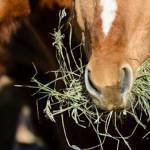Digestive Aids: Does Your Horse Need Them?

The horse’s digestive system is both delicate and complicated. It is easily upset by almost any change in feeding schedule, exercise, emotional state, health status, or medication. Because of the way horses are managed, such changes are often the rule rather than the exception. Owners and trainers sometimes use supplemental digestive aids to prevent upsets and help horses get maximum benefit from their diets.
How does management influence the horse’s digestion?
The horse is designed to eat small amounts of forage almost constantly; to move around freely, most often at a walk or slow trot; and to interact with other horses in a herd situation. Horses that are regularly trained, shown, or worked are often kept alone in stalls most of the time. After long stretches of idle time, they are asked to do an hour or two of fairly strenuous work after which they return to their stables. They may be fed limited amounts of hay interspersed with large grain meals. They are transported, dewormed, vaccinated, tranquilized, medicated, and subjected to visits from an equine dentist. While most owners would consider these practices to be consistent with a conscientious management program, they would also have to admit that a modern horse’s schedule is quite different from that of a wild horse. It is not surprising that the equine digestive system is sometimes negatively impacted by the stresses of day-to-day management.
How is the horse’s digestive system set up?
Digestion begins in the stomach, but most enzymatic breakdown of starch actually takes place in the small intestine where soluble carbohydrates and some minerals, vitamins, fats, and protein are absorbed. Material not digested in the small intestine (mostly fiber along with some leftover carbohydrates) moves on to the cecum and large colon, which make up the hindgut. Billions of microbes (bacteria, fungi, and protozoa) in the hindgut aid in fermentation of cellulose and other fibrous feed elements. The fermentation process leads to the synthesis of protein, vitamin K, and the vitamin B complex, and also produces volatile fatty acids that the horse uses for energy.
The microbial population is made up of several hundred different types and strains of organisms. The numbers and ratios are constantly shifting as the horse eats and drinks, but a healthy balance is usually maintained. Illness, modifications to feed or exercise schedule, or any other kind of stress can cause a large enough change in the intestinal environment to allow one type of microbe to multiply quickly or another type to decline in numbers.
The result of these changes may be mild problems such as diarrhea, or more serious conditions such as colic or laminitis.
How do digestive aids work?
Products defined as digestive aids can be broadly categorized as either probiotics or prebiotics. These aids can be fed as part of the horse’s regular diet, or administered only occasionally in response to a particular need. Probiotics are live microbial cultures. They may include bacteria such as Lactobacillus acidophilus, Streptococcus faecium, and Bacillus subtilis; fungi such as Aspergillus oryzae; and yeast strains such as Saccharomyces cerevisiae. Included in a feed mix in powdered or granulated form, probiotics continually introduce beneficial organisms that may be depleted by daily management. At times when the horse is under particular stress because of shipping, illness, or a busy performance schedule, they may be administered as oral pastes, gels, or liquids.
Prebiotics are substances that support intestinal microorganisms. By providing easily utilized nutrients or creating a favorable environment, prebiotics encourage the growth of a microbial strain that may have been depleted or overwhelmed by a digestive upset. Yeast, a common prebiotic, furnishes amino acids and oligosaccharides that nourish desirable bacteria. There is also evidence that some prebiotics enhance the equine immune system.
Will digestive aids help my horse?
Studies have shown that microbial preparations are beneficial to humans and other animal species, but except for yeast, very little work has been done on the use of probiotics in equines. Research with horses indicates that live yeast culture supplementation helps to limit undesirable changes in the intestinal ecosystem, reducing variations in lactic acid concentrations and pH levels after large grain meals. In growing horses, yeast increased the digestibility of ADF, NDF, calcium, phosphorus, and zinc. Some studies have shown an increase in wither height and weight gain in yeast-supplemented weanlings, while other results did not support this finding.
Many feeds are supplemented with yeast or extra amino acids, so if you use a commercially prepared grain product, you may already be giving your horse a digestive aid. Owners who read supplement descriptions in catalogs may have been tempted to try one of the almost overwhelming arrays of products containing some type of probiotic. Lactobacillus, aspergillus, streptococcus, and bifidobacter cultures have been added to preparations designed to enhance hoof growth, weight gain, foal health, conditioning, ulcer treatment, energy use, sand colic recovery, and senior horse maintenance, to name only a few. Often the description does not specify the particular role the microbial culture is intended to play in the product’s efficacy. Nevertheless, some owners who opt for the “can’t hurt, may help” theory feel that the use of probiotics gives their horses a better chance of staying healthy. Without hard evidence relating to the effectiveness of these products, the decision of whether to use a digestive aid must rest with each horse owner, preferably after consultation with a veterinarian.








